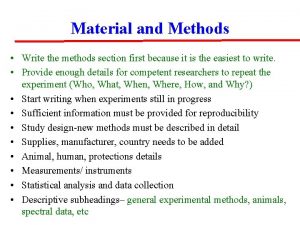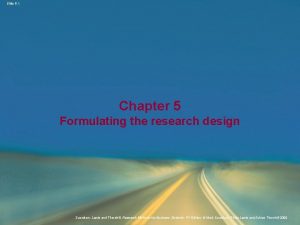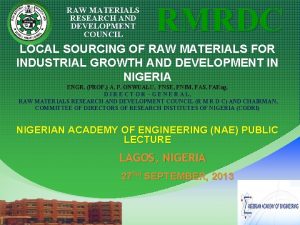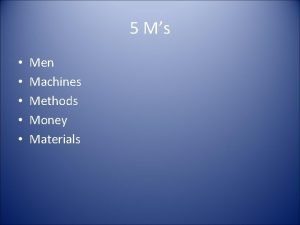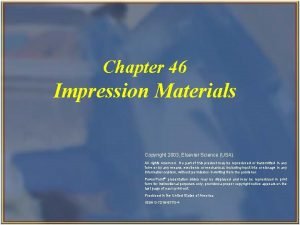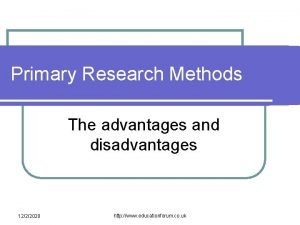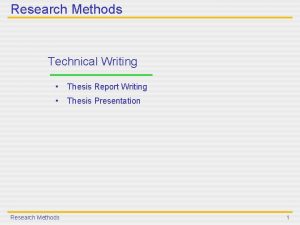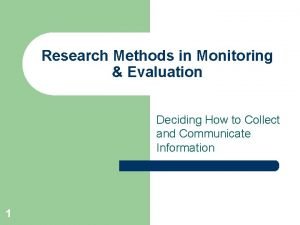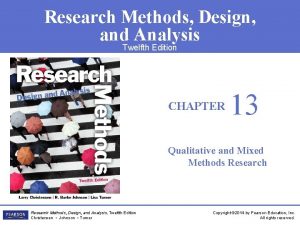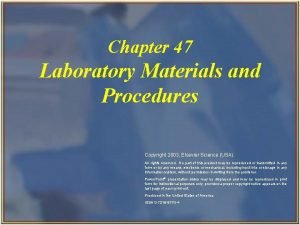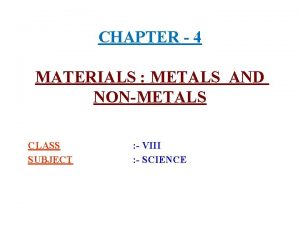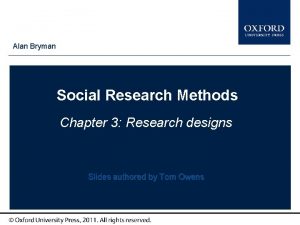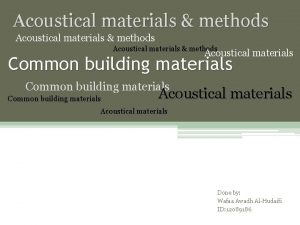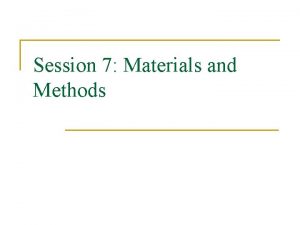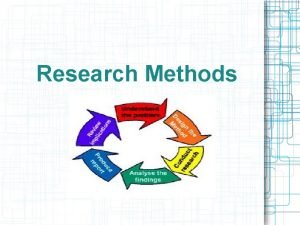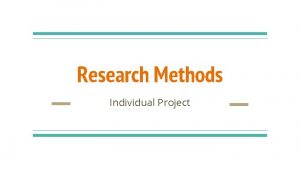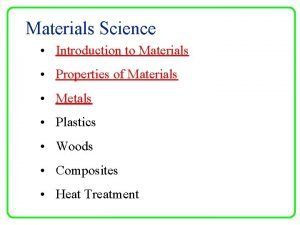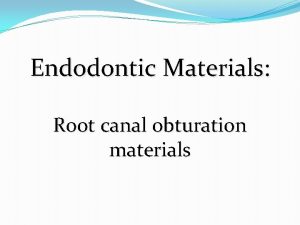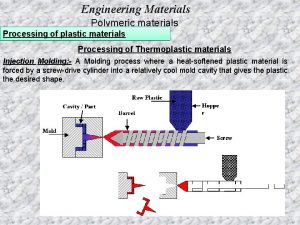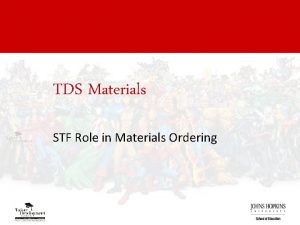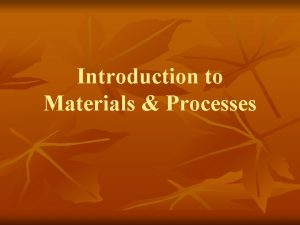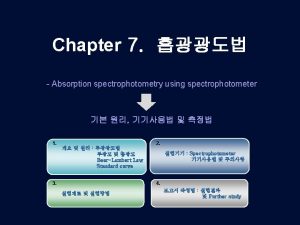Materials and Methods Chapter three Research Methods Is



































- Slides: 35

Materials and Methods Chapter three

Research Methods • Is a set of clearly and fully expressed rules and procedures, upon which the study is constructed and against which claims for knowledge is evaluated. • Thus the study can be replicated by another investigator and constructively criticized.

• The methods or procedures section is really the heart of the research proposal. • The activities should be described with as much detail as possible, and the continuity between them should be apparent.

Cont • Indicate the methodological steps you will take to fulfill every illustrated objective, including the variable used in the study.

Why Study Research Methods? 1. Put the study in logical steps and enable researcher to carry out an organized study 2. Enable researcher to carry out critical of research papers.

The research method includes 1. the population (including inclusion and exclusion criteria), 2. the study area, 3. the study variable, 4. the study designs, 5. Sampling 6. Method of data collection, 7. Analysis and interpretation( ü Ethical considerations ü Budg et ü Timeline

1. Study population • Group of individual units (persons, families, medical records, health facilities etc. ), whom the investigator wants to study and from whom he/she is going to draw the sample

• A brief description of the study population is necessary and should be defined in term of place (the area of the study) and time, as well as the inclusion and exclusion criteria i. e. the specification upon which you decide the selected cases and the criteria you use to avoid other cases.

Study Population • May be defined or hypothetical (potential) individuals

Study Population • May be human

Could hypothetical persons

Study population: could be animals

Study population • Could be deceased people

Inclusion and exclusion criteria • Clearly stated criteria for including participants (subject) patients or volunteers in the study

Where does study population come from? 1. Patients 1. Hospital or clinical facilities 2. Healthy people/ Volunteers 3. Group characterized by their behaviour or occupation 4. Autopsy populations 5. Records of patients or healthy people

2. Sampling: • Mention the population and the sample size you will use to accomplish the study and how you choose the sample • Involve the selection of study unit from a defined study population

a. Sample size: • The bigger the sample, the better the study becomes, but this is not necessary true. It is better to make extra efforts to get a representative sample than to get a very large sample by pre testing the data collection tool. • Generally the desirable sample size is determined by the expected variation in the data. • The sample size should not be less than 50 cases for each variable at least.

3. The study variable • It is a characteristic of person, object or phenomenon that can take different values and can be measured e. g. age, distance, disease …etc. • Variable could be numerical (discrete or continues)

Types of variable: • Dependant variable: the variable used to describe or measure the problem under the study. • Independent variable: the variables that are used to cause or influence the problem.

4. Study design • There were two types: none intervention and intervention. • None intervention study can be Exploratory, Descriptive or Analytical (comparative, explanatory). • Intervention study can be categories into two types: Experimental and Quasi experimental study.

Intervention study type: • Experimental: “manipulation” the researcher does some intervention to one group in the study and compares the finding of the experiment with the control groups. • Quasi experimental: The study groups examine before the intervention and after the intervention (before and after) i. e. there is no separate control group

Selecting a Research Design • The study question will determent whether a quantitative or qualitative approach is appropriate. • A detailed plan of methodology describing exactly what is intend to be done. • This is only possible if researcher has a full understanding of different types of study design.

Data collection • Outline the general plan for collecting the data and Provide a general outline of the time schedule you expect to follow

Data collection • Data collection technique allows the researcher to systematically collect data about object of the study. • For data collection we have to prepare a master data table that shows each of the variable study in a separate column, therefore each row represent separate case. • Usage of an appropriate code for the categorical data with a key shown in the footnote is mandatory.

Example of a simple master data table Gender: 1 = male, 2 = female Tech (Technique): 1 = AP, 2 = PA

Data Analysis • Specify the procedures you will use, and label them accurately (e. g. correlation, Chi 2 test etc…). • Indicate briefly analytic tools you will have available and expect to use (SPSS, SAS etc…) • Provide a well thought-out rationale for your decision to use the design, methodology, and analyses you have selected (summary).

Example

Materials • Ultrasound device • The researcher used mindray ultrasound machine model SSI 8000. The features of the machine are superior contrast, high resolution, 2 D and 4 D imaging, with multi-frequency linear array transducer (7. 5 to 10 MHz) which has variable focal zone protoarency capability. Proper setting of the overall gain (system) gain and time gain or depth gain compensation (TGC/ DGC) was adjusted to optimally visualize each organ. A coupling agent is necessary to ensure good acoustic contact between the transducer and skin and allow total transsimation of the sound beamtransducer water –soluble gel is used , transducer held at a 90 -degree angle to skin , using only minimal pressure so as not to distort the gland anatomy

• study design • This descriptive study research. designed to evaluate isthmus thickness in different age(between 1830 years) and comparing with thyroid volume. using ultrasound B-mode scan for thyroid

• study area • This study was conducted in military hospitalomdurman and aliaa hospital.

• 4 Study duration • This study is conducted during the period extending from March 2020 to June 2020 .

Inclusion criteria and their result were normal echo texture without nodule or any masses affected it. The sample include both gender in age between (18 -20)years. Exclusion criteria Any volunteer have abnormal thyroid , elderly , children and age below 18 year and above 30 years were excluded from this study.

• Sample of study • This study was conducted on 51 person (11 male and 4 o female) with normal thyroid condition in age between (18 -30) years

• Data collection • Demographic data were obtained from all participants direct interview and data sheet was designed. • Method of data collection and storage: • The data collected in the data sheet and then storage in the computer in form of Excel sheet • Ethical consideration • Permission of this study was approved by completely ethical , permission of hospital managers was taken before the beginning , verbally consent and direct questionnaire from participant

 Cant stop the feeling go noodle
Cant stop the feeling go noodle Recognize useful materials
Recognize useful materials Natural man made
Natural man made Adapting and adopting materials
Adapting and adopting materials Methods media and materials
Methods media and materials How to write a materials and methods section
How to write a materials and methods section Direct materials budget with multiple materials
Direct materials budget with multiple materials Research methods for business students chapter 5
Research methods for business students chapter 5 Rmrdc salary for corpers
Rmrdc salary for corpers Chapter 3 research qualitative
Chapter 3 research qualitative Quality control methods for medicinal plant materials
Quality control methods for medicinal plant materials Man machine material money
Man machine material money Syneresis impression material
Syneresis impression material Non aqueous elastomeric impression material
Non aqueous elastomeric impression material Primary research advantages
Primary research advantages Technical background in research
Technical background in research Sampling methods in qualitative and quantitative research
Sampling methods in qualitative and quantitative research Research methods in monitoring and evaluation
Research methods in monitoring and evaluation Research methods design and analysis
Research methods design and analysis Direct wax pattern technique
Direct wax pattern technique Hobbit and orc problem
Hobbit and orc problem Selecting a topic and purpose
Selecting a topic and purpose What is pattern development in technical drawing
What is pattern development in technical drawing Plant assets natural resources and intangible assets中文
Plant assets natural resources and intangible assets中文 Rough sketch and final sketch
Rough sketch and final sketch Chapter 47 laboratory materials and procedures
Chapter 47 laboratory materials and procedures Chapter 4 metals and nonmetals
Chapter 4 metals and nonmetals Applied vs fundamental research
Applied vs fundamental research Contrast applied research and basic research
Contrast applied research and basic research Longitudinal research and cross sectional research
Longitudinal research and cross sectional research Applied vs fundamental research
Applied vs fundamental research Conclusive research design includes
Conclusive research design includes Inquiry in practical research 2
Inquiry in practical research 2 Importance of research problem
Importance of research problem Alan bryman social research methods
Alan bryman social research methods Research methodology lecture notes doc
Research methodology lecture notes doc





